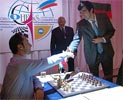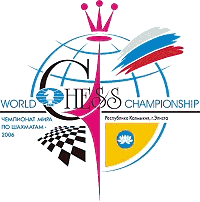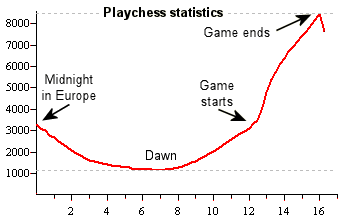
Veselin Topalov vs Vladimir
Kramnik
Twelve games, played from September 23 to October 12 in Elista, Kalmikia.
The games start at 15:00h (3:00 p.m.) local Elista time, which translates
to 11:00h GMT, 13:00h CEST, 12:00h London, 7 a.m. New York. |
|
| Live coverage is available on the official
FIDE site and on Playchess.com
(with live audio commentary by GM Yasser Seirawan for ten Ducats
per day). You can buy them in the ChessBase
Shop. |
Game nine – Saturday, October 7th

Veselin Topalov arriving at the playing venue...
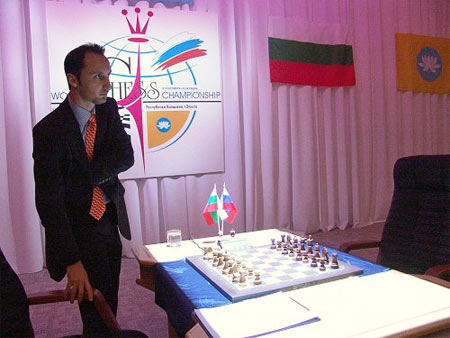
... and taking place at the board on the stage.

Vladimir Kramnik arrives, and the handshake goes without incident

Game nine can begin.
The following express commentary was provided to us by Romanian GM
Mihail Marin, who is the author of a number of very popular ChessBase
training CDs and articles for ChessBase Magazine. GM Marin will study the game
from the World Championship in Elista in greater detail and provide the results
of his analysis in the next issue of ChessBase
Magazine. Note that there is a replay link at the end of the game.
Clicking this will produce a (separate) JavaScript replay window, where you
have replay buttons but can also click on the notation to follow the moves.
Topalov,V (2813) - Kramnik,V (2743) [D12]
WCh Elista RUS (9), 07.10.2006 [Mihail Marin]
The 9th game was a rather one-sided affair. Kramnik made some early
strategic concessions and could not get any kind of tactical compensation.
Topalov did not seem to be in a hurry to convert his considerable advantage,
but this was in fact the shortest way to a win, causing Kramnik to crack under
the psychological pressure. 1.d4 d5 2.c4 c6 3.Nf3 Nf6 4.e3 Bf5. This
is the first time Kramnik deviates from the course of an earlier game of the
match. In the seventh game he transposed to the Queen's Gambit Accepted with
4...e6 5.Bd3 dxc4 6.Bxc4 c5. 5.Nc3 e6 6.Nh4 Bg6 7.Nxg6 hxg6 8.a3!? Almost
never played before. Topalov usually plays ...a6 as Black in the Slav Defence
and now he gives it a try from the other side of the board. I would allow myself
a small divagation. Three quarters of century ago, the somewhat mysterious
Indian player Sultan Khan (not the most erudite theoretician of his time, for
sure) frequently employed the modest advance of the a-pawn with both colours
and irrspective of the opening. Among others, he beat the great Capablanca
in what is called today the Petrosian-Kasparov system and accidentally "invented"
the Chebanenko-Slav much before the birth of the Moldavian trainer. Returning
to our game, the point behind Topalov's last move will become clear soon. 8...Nbd7
9.g3

Veselin Topalov playing 9.g3 in game nine...

...and Vldimir Kramnik contemplating 9...Be7
9...Be7 10.f4. After having eliminated the black light-squared bishop,
White has arranged several of his pawns on dark squares. This is aimed to ensure
the free circulation of his own bishop, which became the unchallenged master
of the light squares. However, combining a3 with f4 also pursues a more concrete
aim. White threatens to block the position with c5, when the thematic central
break ...e5 would be impossible. At the same time, the attempt to undermine
the powerful chain of pawns from the other side with ...b6 is safely answered
by b4, because ...a5 is inoffensive since the b4-pawn has been defended in
advance. This would leave White with considerable advantage of space, without
any possibility of counterplay for Black. 10...dxc4. Giving up the centre
so easily is a risky decision. 10...a5 deserves attention, with the idea to
answer 11.c5 with 11...b6. 11.Bxc4 0-0 12.e4.
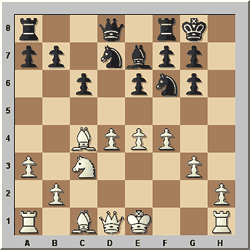
Looking at this position, I cannot stop asking myself: what does it mean to
play a hypermodern opening? 1...d5 is supposed to be a classical way of starting
the game, but isn't here White's advantage in the centre just as big or maybe
even bigger than, say, in the Gruenfeld? One of the reasons why the Slav is
so popular nowadays is that it allows Black choose any type of structure he
wishes, according to the style of play or, why not, the mood in that specific
moment. It can lead to more or less symmetrical positions or to very unbalances
situations. As a compensation for White's advantage of space and powerful pair
of bishops in the current position, Black is few tempi ahead in development.
It remains an open question whether this is enough. Kramnik's play in the next
phase of the game does not really sustain this hypothesis. 12...b5 13.Be2.
We can see here a further merit of a3: in order to undermine the e4-pawn,
Black needs to spend an extra-tempo, allowing White to transfer the bishop
on the optimal square. 13...b4. This seemingly active move implies
a big strategic risk, because it leaves Black's structure in ruins and it opens
new horisons for the f3-bishop, by weakening the c4-square. If the piece pressure
will fail to yield the expected effect, Black will find himself in a hopeless
situation. 13...Qb6 was a more solid option. 14.axb4 Bxb4 15.Bf3 Qb6 16.0-0
e5. This was the counterplay Black was relying on. However, White has sufficient
resources to avoid any structural damage in the centre. 17.Be3 Rad8. Apparently,
a logical move. The d4-pawn is pinned along the g1-a7 diagonal and, indirectly,
along the d-file. However, these minor problems are rather easy to solve. 18.Na4
Black has to release the first pin now. 18...Qb8. This slightly
mysterious move was probably connected with a concrete detail mentioned below.
However, the more active 18...Qb5 might have been better and if 19.Qc2 then
19...exd4 20.Bxd4 c5 followed by ...Nb6, with certain counterplay. 19.Qc2
exf4 20.Bxf4. Kramnik's idea is revealed after 20.gxf4 when 20...Rfe8
creates the threat ...Nxe4 and the generally desirable Bf2 loses the f4-pawn.
However, White's last move maintains the advantage in the centre intact. 20...Qb7
21.Rad1 Rfe8.
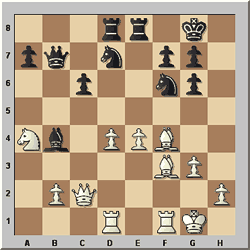
Both sides have completed their development and time has come to make a first
evaluation. Optically speaking, White's advantage is overwhelming. He maintained
his control in the centre, has displayed his bishops actively and has the more
compact structure of pawns. However, converting this advantage into something
more concrete is likely to be a laborious process. It might look tempting to
start advancing the central pawns, but this would just provide the black knights
with stable squares in the centre. At least for a while, it is much wiser to
create simple threats (be them real or imaginary) on the wings, maintaining
the centre intact. This would most probably cause Black to gradually lose his
coordination and then the pawns could advance unhindered. 22.Bg5 Be7 23.Kh1
Nh7 24.Be3 Bg5 25.Bg1 Of course, exchanging pieces would somewhat relieve
Black's position. 25...Nhf8 26.h4 Not only restricting the enemy bishop,
but creating the potential threat of an attack by means of h5. 26...Be7
27.e5 Now that the knights do not have access to d5, this move is well-timed.
In order to defend his c6-pawn, Black is forced to retreat even more. 27...Nb8
28.Nc3 Bb4 29.Qg2 Now, such threats as d5 or h5 start getting contour.
Black's main problem is that he cannot easily guess which are White's intentions
and each minor slip could be decisive. At the same time, White can allow himself
to miss one or two promissing continuations, because they would be there few
moves later, too. 29...Qc8 30.Rc1 Enabling the knight's jump to d5,
eventually followed by Nf4, in order to take under observation one of Black's
last remaining outposts, the e6-square. 30...Bxc3? Black finally cracks
under the pressure. This exchange is equivalent with unconditioned strategic
surrendering. 31.bxc3 Nothing can stop White's pawns now, but it is
remarkable that Topalov will employ the same method as in the previous phase
of the game, maintaining the threat of advancing the centre in reserve.
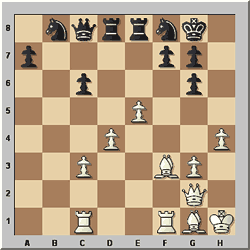
31...Ne6 32.Bg4 Qc7 33.Rcd1 Nd7 34.Qa2. We can feel here the effects
of the huge advantage of space: White's pieces can easily be transferred from
one wing to the other. It might look that White is planning to put the a7-pawn
under pressure, but we shall soon see that his target is much more important.
34...Nb6 35.Rf3 Nf8 36.Rdf1 Re7 37.Be3 White's last piece joins the
attack, threatening Bg5. Suddenly, Black is just lost. 37...Nh7 38.Rxf7!
Nd5 39.R7f3 1-0. [Click to replay]
Photos by courtesy of FIDE
Action on Playchess
It was a fair Saturday afternoon in Europe – early morning in America.
People traditionally go shopping. Or picnic in the woods. Bicycle tours.
Catch a matinee. "You are not going to watch chess, again, are you?"
He is. Together with thousands of others from all over the world, on Playchess.com.
The record for the largest number of visitors logged in simultaneously was
once again broken: over 8500 at peak, testing the power of our chess servers
to their limit. But recent upgrades and optimisation of the server software
paid off: no glitches, in spite of the well-frequented audio commentary board
of GM Yasser Seirawan.
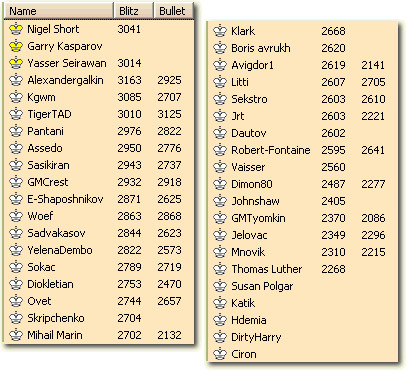
At times there were over 50 GMs watching game nine, discussing with each other
and with the visitors, most of whom are heavily armed with the latest chess
engines. And exciting, turbulent and emotionally charged experience.
Current standing
| Player |
Rating |
1 |
2 |
3 |
4 |
5 |
6 |
7 |
8 |
9 |
10 |
11 |
12 |
Tot. |
Perf. |
| Veselin Topalov |
2813 |
0 |
0 |
½ |
½ |
(1) |
½ |
½ |
1
|
1
|
|
|
|
5
|
2743
|
| Vladimir Kramnik |
2743 |
1 |
1 |
½ |
½ |
(0) |
½ |
½ |
0
|
0
|
|
|
|
4 |
2813
|
| Schedule of the World Chess Championship 2006 |
| Day 17 |
Sun. |
8 Oct |
3:00 p.m. |
Game 10 |
| Day 18 |
Mon. |
9 Oct |
|
Rest day |
| Day 19 |
Tues. |
10 Oct |
3:00 p.m |
Game 11 |
| Day 20 |
Wed. |
11 Oct |
|
Rest day |
| Day 21 |
Thurs. |
12 Oct |
3:00 p.m. |
Game 12 |
| Day 22 |
Friday |
13 Oct |
3:00 p.m. |
Tiebreaks, closing |
Links
